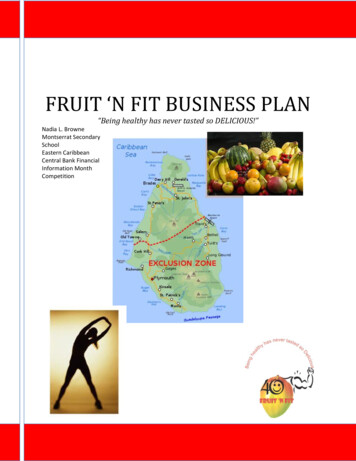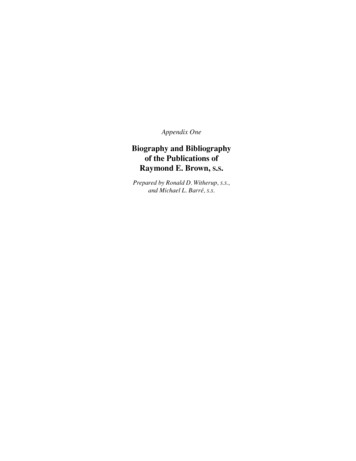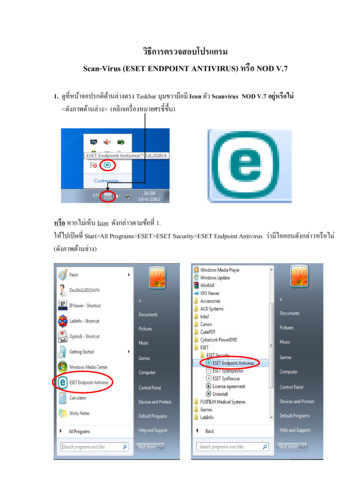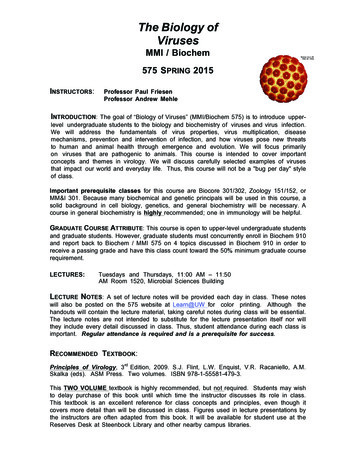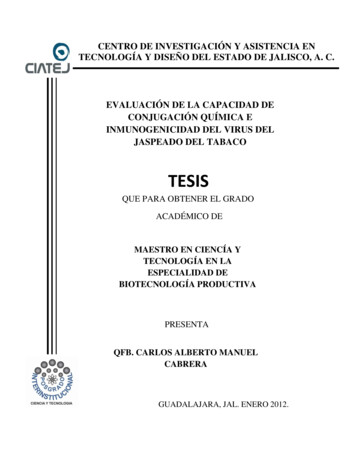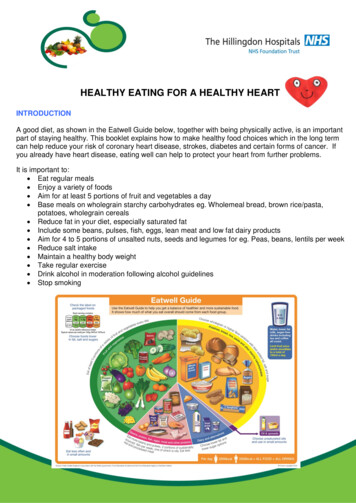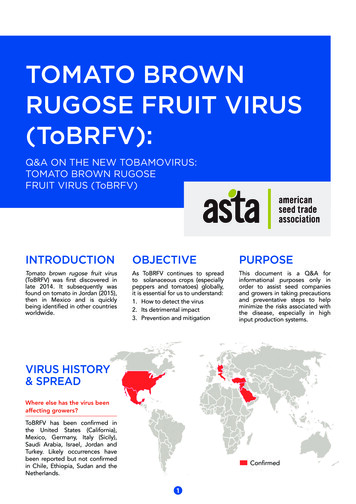
Transcription
TOMATO BROWNRUGOSE FRUIT VIRUS(ToBRFV):Q&A ON THE NEW TOBAMOVIRUS:TOMATO BROWN RUGOSEFRUIT VIRUS (ToBRFV)INTRODUCTIONOBJECTIVEPURPOSETomato brown rugose fruit virus(ToBRFV) was first discovered inlate 2014. It subsequently wasfound on tomato in Jordan (2015),then in Mexico and is quicklybeing identified in other countriesworldwide.As ToBRFV continues to spreadto solanaceous crops (especiallypeppers and tomatoes) globally,it is essential for us to understand:1. How to detect the virus2. Its detrimental impact3. Prevention and mitigationThis document is a Q&A forinformational purposes only inorder to assist seed companiesand growers in taking precautionsand preventative steps to helpminimize the risks associated withthe disease, especially in highinput production systems.VIRUS HISTORY& SPREADWhere else has the virus beenaffecting growers?ToBRFV has been confirmed inthe United States (California),Mexico, Germany, Italy (Sicily),Saudi Arabia, Israel, Jordan andTurkey. Likely occurrences havebeen reported but not confirmedin Chile, Ethiopia, Sudan and theNetherlands.Confirmed1
CHARACTERISTICS & RESISTANCETobamoviruses, as a group, share many similarcharacteristics. How does this virus compare tothose previously described on tomato?There are several tobamoviruses, including TobaccoMosaic Virus (TMV) and Tomato Mosaic Virus (ToMV),in addition to ToBRFV that infect tomato. However, oneof the distinguishing and problematic characteristics ofToBRFV is its ability to overcome all known geneticresistances in tomato, including the Tm-22 gene, andcause severe fruit symptoms on otherwise resistanttomato varieties (see images page 3).Pepper is another primary host for ToBRFV. The Lgenes for resistance to TMV and PMMoV (Pepper mildmottle virus) in pepper currently seem to hold up toToBRFV. Peppers without the resistance gene(s) arehighly susceptible to the virus (see images page 3).In both tomato and susceptible pepper, mechanicaltransmission of the virus occurs extremely easily.Therefore, caution is advised in order to help avoid thepossible transfer of the virus from infected to healthyplants. This commonly occurs via mechanical meanssuch as touching and manipulation of infected plants.The virus can be spread between pepper and tomatoplants, as well as plants of the same crop type, especiallyin transplant productions or in crop production systemsin which plants are regularly handled. The virus can alsospread via infected fruits.ToBRFV is similar to other tobamoviruses in that thevirus particles are long, symmetrical rods. Therefore,it cannot be distinguished by observation by electronmicroscopy. It also has many other characteristicssimilar to those of other tobamoviruses, includingbeing very stable and very infectious.Tobamoviruses are long, symmetrical rod virusesToBRFV, and only preventative crop management andsanitation practices will aide in preventing introduction.or mitigating the spread of the virus and allow for theproduction of a salable crop.Note that it has been reported that some tomatovarieties can develop a high virus level withoutphysically expressing symptoms. Infected plants ofthese varieties can then unwittingly become a sourcefor spread of ToBRFV infection to healthy tomato orsusceptible pepper plants.How long will the seed industry need to develop aresistant variety?Seed companies are diligently working on identifyingand introducing resistance to the virus in new varieties.However, it could take several years until new resistantvarieties are introduced, so it is essential to keep strictsanitary protocols to prevent development and furtherspread of the virus.Are there any resistant tomato varieties?Tomato F1 cultivars that are highly resistant (HR) to ToMVand TMV can be severely affected by this new virus.The known resistance genes do not protect againstLEAF: Symptoms caused by ToBRFV include bubbling and mosaic on leaves of susceptible pepper, and fern leafand mosaic of tomato.2
CALYX: Symptoms include distinct discoloration (browning) of the veins of the calyx in an early stage of tomatofruit development or drying out and browning of the end of the calyx tips.FRUIT: Fruit on infected tomato plants may be undersized with a rough surface. or complete fruit abortionmay occur. Fruit coloration is affected with symptoms such as blotching, pale color and/or brown necrotic spotsoccurring. The number of fruits produced is reduced and fruits could be unmarketable or reduced in quality.Necrosis can occur on susceptible pepper fruit.TO HELP MANAGE THE RISK FROM ToBRFVthe Agdia immunostrip for TMV will give a positivereaction for ToBRFV. This can be used as a prescreen,but confirmation must then be done with additionallaboratory based identification testing.What do the symptoms look like in tomato?The symptoms of ToBRFV are similar to those that occuron leaves, the fruit calyx and the fruit of TMV and ToMVinfected susceptible tomato plants (see images page 2).These symptoms, when they occur on varieties with theTm resistance gene(s), strongly suggest the presenceof ToBRFV. Additionally, symptoms caused by this virusmay be much more severe, especially on the fruit.How will commercial tomato varieties be affected?Even Tomato F1 cultivars with high resistance (HR) toToMV and TMV can be severely affected by this newvirus. There is some indication that ToBRFV may causemore severe symptoms on some varieties vs. others.It is possible that a variety may be infected in whichsymptoms are mild, or not present, but the plants maystill have a high concentration of the virus. Also, notethat as is typical in a tobamovirus infection, symptomsmay vary depending on environmental and growingconditions, especially light and temperature.What are some suggestions if ToBRFV infection issuspected? First, check if the symptoms match with typicalsymptoms of tobamovirus. It would then be prudent to isolate suspectedplants and surrounding plants (at least 1.5 meterssuggested), and to initially handle them throughsanitary precautions in the same way as would bedone with known tobamovirus infections.Can growers use chemicals to cure infected plants?No chemicals can be used to cure an infected plant;however precautions such as the use of disinfectantsto sanitize surfaces and implements can be helpful incontrolling the spread of the virus. If tobamovirus symptoms occur on a variety withknown resistance, it increases the likelihood that itcould be ToBRFV. However further tests would beneeded for verification. It has been reported that3
Can ToBRFV be found on the seed?for detection of tobamoviruses, detects ToBRFV.It is a local lesion assay which involves inoculationof indicator tobacco plant leaves with tomato andpepper seed, respectively, ground in buffer matters/seed-health/ishi-veg-protocols/). In addition, ELISAcan be used as a pre-screen to evaluate seedlots forthe presence of ToBRFV. It detects the presence ofvirus coat protein but does not determine if the virusis viable or not. Therefore, a positive result with ELISAshould be followed with a confirmatory test such as thelocal lesion assay.ToBRFV, like other tobamoviruses, can occur inassociation with tomato and pepper seed. It is thoughtto be found primarily on the seed surface, and to alesser extent internally in the seed, and can maintainits infectivity for years. By testing all sources of seed(experimental, parent, trial varieties or commercial),or if grafting is performed with tomato, the seed ofthe rootstock and scion, it is possible to detect thepresence of living and pathogenic virus. An appropriatesampling and testing method should be used. TheInternational Seed Health Initiative (ISHI-Veg) methodSUGGESTIONS TO TRY AND LIMIT THE SPREAD OF ToBRFV: What can be done in the transplant nursery? Inspect transplants, especially prior to grafting(if used) weekly for visible symptoms of ToBRFV.Note that symptoms may not be visible on infectedyoung plants. However, If infected plants aredetected in the transplant nursery, it is possible thatother nearby seedlings are infected as well. In thiscase, it is recommended to confirm the presenceof ToBRFV, and then to eliminate all plants withina minimum of 1.5 meters beyond the outermostsymptomatic plant because it is possible thatthese plants also have been infected, but havenot yet developed symptoms. Be careful not to touch other surfaces during theplant removal process. Cutting off irrigation to theplants to be removed a day prior to the process willresult in a lower risk of sap transfer and inspectionspread. After removal, dispose of these plantsby incineration. Sterilize or destroy all plant traysthat contained infected plants. All crop debrisand substrate must be removed and buried orincinerated in a manner to avoid airborne debris. Work areas, tools or machinery must be cleaned anddisinfected. Several products, including potassiumperoxy-monosulfate (Virkon S) or freshly prepared0.5% sodium hypochlorite (NaOCl) bleach, can beeffective disinfectants. In protected productionsthe use of Non-Fat Dry Milk (NFDM, 3.5% protein)helps prevent spread of tobamoviruses. Preferablyuse protective clothing that will stay inthe greenhouse after use. Clean work boots and/or shoes with disinfectantbefore entering and after leaving the greenhouse. Sanitize cutting tools and other implementsafter each plant with disinfectant. Thoroughly clean and disinfect the greenhouse atthe end of a crop season.Infected crop:If an infected plant is detected (confirmation of thediagnosis to be done by a specialized laboratory).It is recommended: To carefully remove symptomatic plants anddestroy them by burying or incineration in a mannerto avoid airborne debris. To treat each infected greenhouse as a separateunit. Use specific protective clothing (lab coat andgloves) and tools and store them in the greenhouse.Do not move them to another greenhouse. Startevery day with cleaned clothes. Wash all clothes inhot water and soap before using them again. To wash hands with soap. Small tools can bedipped in a Non-Fat Dry Milk (NFDM) 3.5% proteinsolution. Milk has the advantages of being effective,safe and inexpensive. To limit access to the facilities to authorizedpersonnel only. To prevent spread in the greenhouse, the areasurrounding the one from which infected plantshave been removed should be worked last. Do not assume that asymptomatic plants are notinfected. It takes several days from initial infectionfor symptoms to develop. Also, some varieties maybe asymptomatic despite infection by the virus. If possible, adjust the daily operations based onthe sanitary status of the greenhouses by avoidingmoving from an infected greenhouse or field to anon- infected one. At the end of cultivation make sure that all materials,and the greenhouses are cleaned and disinfected.During cultivationHealthy crop: Onlyenter the crop with clean (washed) clothes. Prevent any unnecessary visits and do not touchplants if not absolutely needed. Be aware that clothes could be contaminatedduring the eating of tomatoes at home, or throughexposure in infected nurseries or greenhouses. Follow good hygiene practices by washing handswith soap or disinfectants before and afterhandling plants. Use a small nail brush to improvethe hand washing process.4
HOW LONG WILL THE VIRUS HAVE AN IMPACT?Tobamoviruses are very stable and can survive forlong periods in infected crop debris, in the soil or oncontaminated surfaces. On surfaces such as a benchtops, survival could be weeks to months (see ASTACGMMV Bulletin) and in infected plant debris, survivalcan be for as long as the infected debris remains intact.Spread of the virus can occur very readily by mechanicaltransfer, especially in protected or high input culturesystems where plants are pruned, staked, handledor touched frequently. In open field productionsmachinery used for cultivation or weed control canspread the virus, and there are some reports thattobamoviruses can spread in irrigation water.SUMMARY: KEY POINTS ABOUT ToBRFV1. ToBRFV, is a highly virulent very aggressive virus that can cause severe infection ontomatoes with resistance genes including Tm-22, and susceptible peppers that lackthe L resistance genes.2. This virus can spread quickly and easily by mechanic transmission, especially underintensive production practices.3. Symptoms may vary by variety, and in some cases, infected varieties may beasymptomatic. Typically, infected plants have fruit with severe symptoms.4. Leaf symptoms include distortion, shoestring and fern leaf; calyx symptoms includebrowning of the veins. Affected fruit may be aborted or small with blotching orbrown spots.6. The virus can VERY easily be moved from plant to plant by workers or even from rootto root contact. Personnel coming from an infected greenhouse can introduce thevirus if proper sanitation measures are not n place.7. ToBRFV is very stable and can survive for long periods in infected debris, in the soilor on contaminated surfaces.8. Do not rely on genetic resistance to tobamovirus to provide control, especiallywith tomato. Strict sanitation measures must be implemented including using cleanclothing, tools and implements, stakes, etc.9. Symptomatic plants can be removed and destroyed but ONLY very carefully, beingsure not to touch any other plants or surfaces. Do not move from infected to cleangreenhouses. Approach each production as if there is no resistance to this highlytransmittable and damaging tobamovirus.10. If you find plants with tobamovirus symptoms, especially if the variety has geneticresistance, obtain a professional diagnosis for confirmation.11. Overall, best practices for prevention are essential. Workers should wear protectiveclothing when moving between greenhouses, especially disposable coats andgloves. Even if the virus has not been detected, this should be standard procedure.GUIDE PRODUCED BY5Communication Division HMC4314 0319 Tous droits réservés - 2019 HM.CLAUSE AdobeStock - Logo Graph5. The virus behaves similarly to other tobamoviruses such as TMV or ToMV, but thesymptoms (especially in the fruit) may be much more severe.
Turkey. Likely occurrences have been reported but not confirmed in Chile, Ethiopia, Sudan and the Netherlands. INTRODUCTION Tomato brown rugose fruit virus (ToBRFV) was first discovered in late 2014. It subsequently was found on tomato in Jordan (2015), then in Mexico and is quickly
